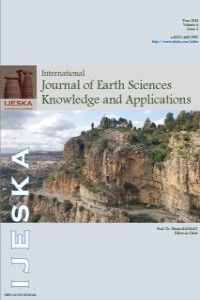Abstract
References
- Agunleti, Y.S., Jaiyeola, G.B., 2015. Application of electrical resistivity techniques to decipher granitic dyke within sedimentary terrain for quarry purpose. International Journal of Emerging Technology and Innovative Engineering I(6), 38-44.
- Chambers, J.E., Kuras, O., Meldrum, P.I., Ogilvy, R.D., Hollands, J., 2006. Electrical resistivity tomography applied to geological, hydrogeological and engineering investigations at a former waste disposal site. Geophysics 71, B231-B239.
- Friberg, N., 2023. Geological 3D Modelling of the File Hajdar Quarry, Slite. Degree Project at the Department of Earth Sciences, ISSN 1650-6553 Nr 617, 45 p.
- Kayode, J.S., Arifin, M.H., Nawawi, M., 2019. Characterization of a proposed quarry site using multi-electrode electrical resistivity tomography. Sains Malaysiana 48 (5), 945-963, http://doi.org/10.17576/jsm-2019-4805-03.
- Kozak, M., 2021. Demiryolu balastının ve özelliklerinin araştırılması. Demiryolu Mühendisliği, 13, 86-96, https://doi.org/10.47072/demiryolu.831684 (in Turkish).
- Larsson, M., 2022. 3D Geological Modelling of the Subsurface Adjacent to Cementa’s Quarry in Skövde, Sweden. Degree Project at the Department of Earth Sciences ISSN 1650-6553 Nr 582, 40 p.
- Martial, Y. A., Nicolas, K. L., Constantin, A. E. B. J., Celestin, S. B., 2023. 3D modeling and estimation of the tonnage of the granite quarry of Linguésso (North-West of Côte d’Ivoire) by electrical methods. Journal of Geoscience and Environment Protection 11, 138-154. https://doi.org/10.4236/gep.2023.113010.
- Özdemir, A., Savaş, İ., 2009. Maden aramacılığında bir gelişim; çok-elektrotlu özdirenç görüntüleme. Madencilik Türkiye Dergisi 2, 24-29 (in Turkish).
- Özdemir, A., Palabıyık, Y., 2019a. Yüksek sıcaklıklı ve derin jeotermal sahaların rezistivite ölçümlerinin jeolojik yorumlama yöntemleri: Batı Anadolu’dan bir çalışma. Avrupa Bilim ve Teknoloji Dergisi 17, 1075-1091 (in Turkish). https://doi.org/10.31590/ejosat.653203.
- Özdemir, A., Palabıyık, Y., 2019b. Güney (Denizli) civarında jeotermal enerji arama: Derin düşey elektrik sondaj (DES) ölçümlerinin jeofizik ve jeolojik yorumu. Avrupa Bilim ve Teknoloji Dergisi 17, 1198-1214 (in Turkish). https://doi.org/10.31590/ejosat.653565.
- Uhlemann, S., Chambers, J., Falck, W.E., Alonso, A.V., González, J.L.F., de Gea, A.E., 2018. Applying electrical resistivity tomography in ornamental stone mining: Challenges and solutions. Minerals 8, 491, https://doi.org/10.3390/min8110491.
- Yi, M., Kim, J., Song, Y., 2006. Application of 3D resistivity tomography to delineate subsurface structures. Exploration Geophysics, 37, 268-27, https://doi.org/10.1071/EG06268.
Abstract
This study aims to investigate the presence, thickness, and vertical and lateral extension of limestone and basalt in quarry sites by geophysical methods and to perform 3D geophysical subsurface modeling. Within the scope of the study, firstly, regional gravity and airborne magnetic data were obtained, and maps were prepared and interpreted to estimate the presence, thickness, and vertical and lateral extent of limestone and basalt in the areas selected as quarries by geophysical methods. In the second stage, in-situ geological observations were made to examine the geological characteristics and to guide the geophysical measurements to be made in these areas. In the third stage, geophysical measurements were carried out at suitable locations determined by geological observations. In the last stage, computer-aided 3D subsurface modeling of the study areas was carried out in light of the geophysical data obtained. As a result of the studies, areas that are suitable and unsuitable for quarrying were identified. This study demonstrates that geophysical methods (especially resistivity method) can be fast, reliable and cost-effective methods for quarry site research.
Keywords
Quarry site Crushed stone Resistivity Vertical electrical sounding (VES) 3D geophysical modelling
References
- Agunleti, Y.S., Jaiyeola, G.B., 2015. Application of electrical resistivity techniques to decipher granitic dyke within sedimentary terrain for quarry purpose. International Journal of Emerging Technology and Innovative Engineering I(6), 38-44.
- Chambers, J.E., Kuras, O., Meldrum, P.I., Ogilvy, R.D., Hollands, J., 2006. Electrical resistivity tomography applied to geological, hydrogeological and engineering investigations at a former waste disposal site. Geophysics 71, B231-B239.
- Friberg, N., 2023. Geological 3D Modelling of the File Hajdar Quarry, Slite. Degree Project at the Department of Earth Sciences, ISSN 1650-6553 Nr 617, 45 p.
- Kayode, J.S., Arifin, M.H., Nawawi, M., 2019. Characterization of a proposed quarry site using multi-electrode electrical resistivity tomography. Sains Malaysiana 48 (5), 945-963, http://doi.org/10.17576/jsm-2019-4805-03.
- Kozak, M., 2021. Demiryolu balastının ve özelliklerinin araştırılması. Demiryolu Mühendisliği, 13, 86-96, https://doi.org/10.47072/demiryolu.831684 (in Turkish).
- Larsson, M., 2022. 3D Geological Modelling of the Subsurface Adjacent to Cementa’s Quarry in Skövde, Sweden. Degree Project at the Department of Earth Sciences ISSN 1650-6553 Nr 582, 40 p.
- Martial, Y. A., Nicolas, K. L., Constantin, A. E. B. J., Celestin, S. B., 2023. 3D modeling and estimation of the tonnage of the granite quarry of Linguésso (North-West of Côte d’Ivoire) by electrical methods. Journal of Geoscience and Environment Protection 11, 138-154. https://doi.org/10.4236/gep.2023.113010.
- Özdemir, A., Savaş, İ., 2009. Maden aramacılığında bir gelişim; çok-elektrotlu özdirenç görüntüleme. Madencilik Türkiye Dergisi 2, 24-29 (in Turkish).
- Özdemir, A., Palabıyık, Y., 2019a. Yüksek sıcaklıklı ve derin jeotermal sahaların rezistivite ölçümlerinin jeolojik yorumlama yöntemleri: Batı Anadolu’dan bir çalışma. Avrupa Bilim ve Teknoloji Dergisi 17, 1075-1091 (in Turkish). https://doi.org/10.31590/ejosat.653203.
- Özdemir, A., Palabıyık, Y., 2019b. Güney (Denizli) civarında jeotermal enerji arama: Derin düşey elektrik sondaj (DES) ölçümlerinin jeofizik ve jeolojik yorumu. Avrupa Bilim ve Teknoloji Dergisi 17, 1198-1214 (in Turkish). https://doi.org/10.31590/ejosat.653565.
- Uhlemann, S., Chambers, J., Falck, W.E., Alonso, A.V., González, J.L.F., de Gea, A.E., 2018. Applying electrical resistivity tomography in ornamental stone mining: Challenges and solutions. Minerals 8, 491, https://doi.org/10.3390/min8110491.
- Yi, M., Kim, J., Song, Y., 2006. Application of 3D resistivity tomography to delineate subsurface structures. Exploration Geophysics, 37, 268-27, https://doi.org/10.1071/EG06268.
Details
| Primary Language | English |
|---|---|
| Subjects | Marine Geology and Geophysics |
| Journal Section | Research Articles |
| Authors | |
| Publication Date | August 31, 2024 |
| Submission Date | July 26, 2024 |
| Acceptance Date | August 20, 2024 |
| Published in Issue | Year 2024 Volume: 6 Issue: 2 |


